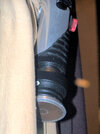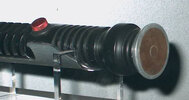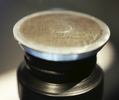I've gone down that rabbit hole, don't forget curtain rods and antique bed frames.I have spent so many hours staring at the Obi TPM and QGJ hero saber props at this point. The more I stare at them, the more I think the original masters used to make the black resin pieces were made from wood. Just something about the organic shapes, the way certain corners are rounded, etc. Who knows, maybe they were even originally found items? Perhaps the pommels were ornate wooden post caps/finials like you'd find on stairs or wooden furniture feet. Maybe they were custom made for production and turned on a wood lathe in the same style as decorative/furniture pieces. Just a random thought that's been hanging out in my brain.
View attachment 1693146
View attachment 1693148
View attachment 1693147
You are using an out of date browser. It may not display this or other websites correctly.
You should upgrade or use an alternative browser.
You should upgrade or use an alternative browser.
Dewy and Anakin Starkiller's Accurate Qui-Gon Jinn Lightsaber Design
- Thread starter Dewy
- Start date
The pommel and other original pieces being turned wood on a lathe is how I always imagined it happening. The less accurate method of wood turning vs machining metal or plastic combined with the imperfect nature of resin casting perfectly explains how these sabers (especially the stunt versions) can be so warped and have parts that are inaccurate in spacing or sizing. I work in architecture and most of the more affordable trim work, finish stair or moulding work that we do involves opening up books with images just like the ones you posted above, so it seems very plausible to me that they would have been inspired by that. Curves made by circles are generally boring and traditional mouldings/turnings are the most common source for complex curves that are aesthetically pleasing.
At any rate keep up the great work, can’t wait to get my Obi-Wan saber and get signed up for this one!
At any rate keep up the great work, can’t wait to get my Obi-Wan saber and get signed up for this one!
So what’s the consensus here on the color?
I know warm tonal reflection has been mentioned but if that were completely the case the same would have to be true of the polished aluminum reflection and I don’t think I get quite the same sense of that.
Based on the face of the emitter on the resin stunt: I’d think that it may be a machined or otherwise burnished thick mild steel washer (like the obi wan Hilt) and bolt that has rusted.
Actually, since even zinc plate or stainless will rust if it is treated with an abrasive that has mild steel used in it prior. (It leeches into the surface if it’s not cleaned properly) those materials wouldn’t need to be ruled out
I know you guys have your other reference: does any more sense come of it there?
Filandrius
Sr Member
I think that it makes sense that the washer and bolt would be the same exact ones used on the Obi-Wan, no?
Presumably? Also looking at the washers for the screen used Maul emitters… I’m just mentioning the color difference (at least in these photos) could be in part due to some surface oxidation or material treatment not necessarily a ‘difference in material’. I just know it’s not copper as has been suggested by other replications.I think that it makes sense that the washer and bolt would be the same exact ones used on the Obi-Wan, no?
lesternessman
Sr Member
I’m sure the fender washer will oxidize over time, but I prefer mine looking like it was in the movie and not like it’s been on display in museums. Can’t wait to see the finished piece!
Based on my observations I agree that they’re plain steel, or possibly zinc plated steel washers (with the zinc sanded off).
The picture below is my prototype Obi TPM saber on the left and the new production one on the right. You can see how much the plain steel darkened in ~8 months just from sitting in my living room.

The picture below is my prototype Obi TPM saber on the left and the new production one on the right. You can see how much the plain steel darkened in ~8 months just from sitting in my living room.
Thanks for these Drew.
It looks like there’s a cutoff burr in between the aluminum ring and the washer that didn’t quite get cleaned out, that could be an indicator that they cut this ring themselves from round barstock.
Based on the burnishing marks the steel (definitely rusted) and the end of that aluminum emitter end cap must have been sanded at the same time. Perhaps it was a tapped and press-fit one off? In that case- it is a strong argument for mild steel. If it were stainless I don’t think it would be quite *that* rusted and if it were a zinc plated washer I don’t think that burr would be present even if modified.
(Just positing theories if not already mulled over)
*edit* however the inner and outer rings of the washer are bright still: so perhaps it *was* a coated washer? Just not sure how that burr would be present then…

(This rusted burr)
It looks like there’s a cutoff burr in between the aluminum ring and the washer that didn’t quite get cleaned out, that could be an indicator that they cut this ring themselves from round barstock.
Based on the burnishing marks the steel (definitely rusted) and the end of that aluminum emitter end cap must have been sanded at the same time. Perhaps it was a tapped and press-fit one off? In that case- it is a strong argument for mild steel. If it were stainless I don’t think it would be quite *that* rusted and if it were a zinc plated washer I don’t think that burr would be present even if modified.
(Just positing theories if not already mulled over)
*edit* however the inner and outer rings of the washer are bright still: so perhaps it *was* a coated washer? Just not sure how that burr would be present then…
(This rusted burr)
Last edited:
Thanks for these Drew.
It looks like there’s a cutoff burr in between the aluminum ring and the washer that didn’t quite get cleaned out, that could be an indicator that they cut this ring themselves from round barstock.
Based on the burnishing marks the steel (definitely rusted) and the end of that aluminum emitter end cap must have been sanded at the same time. Perhaps it was a tapped and press-fit one off? In that case- it is a strong argument for mild steel. If it were stainless I don’t think it would be quite *that* rusted and if it were a zinc plated washer I don’t think that burr would be present even if modified.
(Just positing theories if not already mulled over)
*edit* however the inner and outer rings of the washer are bright still: so perhaps it *was* a coated washer? Just not sure how that burr would be present then…
View attachment 1695956
(This rusted burr)
It could be a burr, but in some of the photos you can see what I think is glue residue. One example:
Fair point! Mild steel dust from sanding stuck in curing glue? Would also rust.. I could see that (legit explanation)
That’s a really good point, I’ve always thought they sanded the emitters down after the sabers were assembled. They would have just shoved them up against a belt sander. It didn’t occur to me that all the dust would get stuck in the crevices.
Yep, probably didn’t wait for them to *fully*cure either so there could have well been some sticky residue in there. At the time they were probably bright and shiny ready for filming and none the wiserThat’s a really good point, I’ve always thought they sanded the emitters down after the sabers were assembled. They would have just shoved them up against a belt sander. It didn’t occur to me that all the dust would get stuck in the crevices.
All caught up… this is incredible
Welcome back, Sir. It’s been a wild ride you’ve missed!
Welcome back, Halli! I missed ya, bud.All caught up… this is incredible
Welcome back, Sir. It’s been a wild ride you’ve missed!
Thanks boys, it’s been a journey…Welcome back, Halli! I missed ya, bud.
Similar threads
- Replies
- 379
- Views
- 33,188
- Replies
- 43
- Views
- 3,148
- Replies
- 2
- Views
- 482



